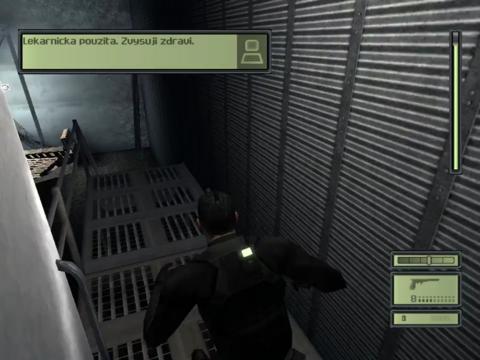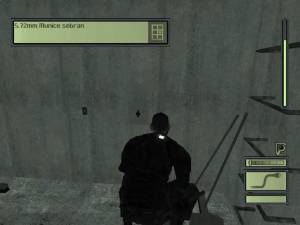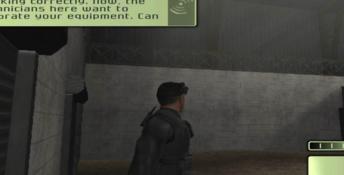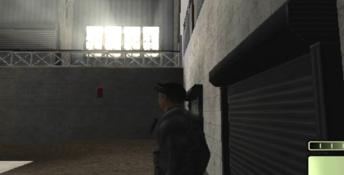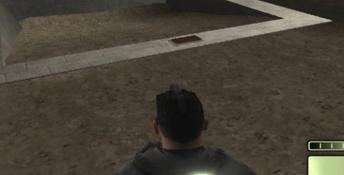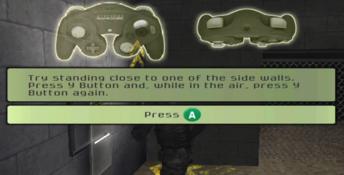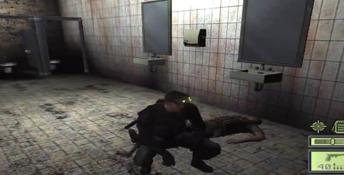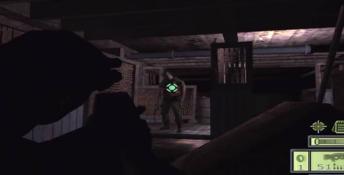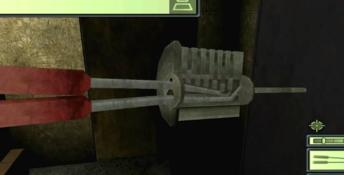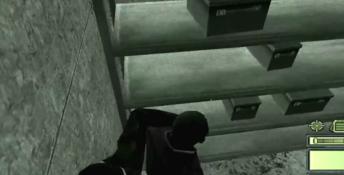Tom Clancy's Splinter Cell

| a game by | Ubisoft |
| Genre: | Action |
| Platforms: | GameCube, XBox, PC (2002), Playstation 2, GBA |
| Editor Rating: | 8.6/10, based on 8 reviews, 10 reviews are shown |
| User Rating: | 7.7/10 - 18 votes |
| Rate this game: | |
| See also: | Tom Clancy’s Games, Splinter Cell Games |
Splinter Cell May be the best looking and most anticipated game this side of Doom III, but an even more impressive fact is that it's actually running on schedule. This means you have less than two months to wait before stealth action gets a new name with the arrival of hero Sam Fisher.
To be honest though, what the hell sort of name is Sam Fisher? We told Ubi Soft: it's all very well having the best looking stealth game ever with your fancy Unreal engine and your real-time lighting and shadows, but if you want to beat Solid Snake, you’re going to need a hero that sounds just as cool, just as... macho (not in a Village People way, mind). I mean, 'Solid Snake'. It practically screams: "I’ve got a huge todger and there's nothing you can do about it." We told them: if you want cool and manly, call him 'Mandrake McFreeze’, or 'Colossal Balzac'. Call him 'Girth Johnson' and his heroine Niagra Honeywell'; just don't give him some pussy name like Samuel, or Dave. They seemed to be listening, but there must have been copyright complications or something, because they didn't follow through. Such a shame... 'Sam Fisher'. Sounds like someone you might buy insurance from. "Move over Robert from Accounts, here comes Sam Fisher to redefine stealth spread-sheeting."
Still, we have to admit the game does look pretty goddamn amazing. It has all those shadowy bits and gadgety things, and Mandrake. I mean Sam, has a few cool tricks up his sleeve too. Even if he does have a small wiener.
Download Tom Clancy's Splinter Cell

System requirements:
- PC compatible
- Operating systems: Windows 10/Windows 8/Windows 7/2000/Vista/WinXP

System requirements:
- PC compatible
- Operating systems: Windows 10/Windows 8/Windows 7/2000/Vista/WinXP

System requirements:
- PC compatible
- Operating systems: Windows 10/Windows 8/Windows 7/2000/Vista/WinXP
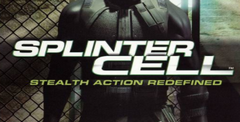
System requirements:
- PC compatible
- Operating systems: Windows 10/Windows 8/Windows 7/2000/Vista/WinXP

System requirements:
- PC compatible
- Operating systems: Windows 10/Windows 8/Windows 7/2000/Vista/WinXP
Game Reviews
Stealth-Action. It s a strange concept you must admit. Here you are, this elite undercover operative, invincible stealth assassin or whatever, conducting a mission of the utmost danger, and yet you spend your whole time sneaking around out of sight, hiding, waiting for an opening, and generally doing... nothing. All those years of training in weapons, languages, martial arts, espionage, and here you are just hanging around in the shadows like some sort of froth-lipped, fidgeting pervert trying to steal a glimpse of pink flesh through your neighbour's lace curtains. Waiting... watching... scratching... getting cramp.
And yet, strangely enough, pretending to do next to nothing is some of the best fun you've ever had in front of a computer screen. The atmosphere is palpably intense, the fear of discovery overwhelming; the sense of mastery felt as an enemy wanders past you, completely oblivious to your presence: impossibly satisfying. Thus is the power of invisibility.
And eventually, of course, the moment strikes. The moment when all your training comes to bear, when you spring into action and... chop, snap, gurgle, miaow, another victim falls prey to your special brand of silent death. It's not about just overcoming your opponent; it's about doing it silently, undetected, unseen. Doing it with style. And this is what Ubi Soft's imminent stealth-action blockbuster Splinter Cell is all about. Maximising your options -maximising the number of different, cool ways you can eliminate your foes. Or disable them. Or avoid them.
As Gregoire Gobbi, producer on Splinter Cell, explains: We've designed the game so that in 90 per cent of cases you can choose exactly how to handle things. We build the world, we simulate some rules that are simple and easy to understand, we give you some tools, and then you do whatever you want to reach your objective."
To Kill With Intrigue
It's this kind of freedom, coupled with the fact that the game looks absolutely gorgeous, that's caused actual ripples of excitement whenever Splinter Cell has appeared in public. Best Action/Adventure Game at E3, Overall Best Game of Show at ECTS - hell, we've been raving about it ourselves since it was unveiled in Montreal earlier this year. This time, however, we've played it, or at least a couple of levels of it, and have tasted some of that freedom first-hand.
Of course when we say you can do whatever you want', it doesn't quite mean that hero Sam Fisher can spy on enemies with the old eyeholes in the newspaper' trick, or overcome enemies with a swift Vinnie Jones-style plum squeeze. There's no doubt though that he's a resourceful chap with more than a few tricks up his sleeve.
Gregoire is eager to stress this as we approach the first door in our first level of the game. Before entering a room, you can do several things. You can shoot out the lights outside so you can't be seen in the doorway. You can also use your snake cam, to give a sneak preview of what's going on in the next room." Obligingly, I select the optical cable camera from my inventory and use it to peek under the door. A grainy fish-eye view of the next room appears: inside, a guard stands restlessly between cells of prisoners, his back to the door.
Gregoire continues: Once you get inside you can do many things. You can just look, trying to understand the pattern of the guards' movements so that you can sneak through the area. You can shoot out all the lights with your silenced weapon, which will make a noise that the guard will investigate, but it will make things easier for you if you get away with it. Or you can just shoot the guards with your sniper scope, regulating your breath to get a steadier target. At this point, the reticule hovering over the guard's unwary form gets the better of me, and I unload half a clip into his back. I receive a disapproving glance, but it seems to do the trick.
Gritty Realism
Anyone familiar with the exploits of Solid Snake will recognise the aim-steadying feature mentioned here as an idea cribbed from Metal Gear Solid. But whereas in that game you popped a nice calming Diazepam to aid your sniping, Sam Fisher simply holds his breath. Not as cool perhaps, but certainly more believable. This is a Tom Clancy game after all, and hence set in a rigorously almost-real, day-after-tomorrow universe. All the gadgets, weapons, technology - even the political situation that frames the plot - either exist today or very easily could within the next five years. (In fact, most of the gadgets can be bought at Spymaster.com if you're sufficiently cashed up - and unnaturally paranoid.) Whether or not this realism is a good thing or not is probably a matter of taste.
In any case. Grdgoire quickly regains his train of thought. You could also have shocked him with your sticky shocker, putting him out of commission for a couple of hours. Or waited until he wandered away, used your split-jump thing to straddle the corridor and shoot out one of the lights so that he came to investigate. Then once he walked underneath you, you would just have needed to drop down on his head and knock him out. Maybe next time, eh?
By this stage it's becoming clear that there are three main ways to tackle any given situation. You can be stealthy, remaining in the safety of the shadows at all times and avoiding confrontation. Your light meter tells you how visible you are, and if no shadow exists, you simply create one by knocking out the lights when no one's looking. You can use your gadgetry, such as your sticky shocker and snake cam, overcoming enemies with your superior equipment budget. Or you can use your athletic moves - dive rolling, split-jumping, abseiling and pole-climbing your way past any given threat. Usually, of course, it's a combination of all three.
You're Sacked
In fact, the only thing you can't do is go in all guns blazing. I tried this a couple of times, and apart from being swamped with guards every time and running out of ammo, I also failed the mission simply by virtue of breaking my orders to keep a low profile. This seemed like a bit of a cheap way to enforce stealthy behaviour, as the game should make you want to stay hidden for fear of your life rather than your boss, but we're assured this will be properly balanced by release day.
All the NPCs have an alert state signifying their state of vigilance, explains Gregoire. Every time a security breach is detected, the alert state in the whole level will go up a notch -permanently, making progress that much harder. Security breaches don't just mean getting spotted by a surveillance camera either - all dead bodies must be extremely well hidden if they are not to be found and reported.
Getting back to the mission at hand, we soon find ourselves at the next threat -a geek in a laboratory with a keyboard round his neck. This time, on Gregoire's advice, I spare his life. If you sneak up behind him and use the action key, you'll get him in a submission hold. Once again I oblige, and Sam grabs the lard-ass round the neck and puts a gun to his head. Now you can either interrogate him, use him as a human shield or discard him." I decide to do all three, in turn, pausing to admire the excellent quality of the voice-acting in the ensuing exchange.
Soon enough the tubby egghead is lying on the ground, unconscious. Another mission objective appears on my interface, but by then I am enjoying the spray of glass and shrapnel as I shoot every breakable item in the room, laughing maniacally as I go. Gregoire looks on, frowning.
Go On Boss
So far I've eliminated only two foes, but if you're talking stealth and style, it doesn't come much better than this. Stuffy academic types are always quick to tell us that videogames are about exercising power. Well, if shooting a bunch of witless, scuttling Nazis in the head with a machine gun gives you a kick, how much more satisfying is it going to be to lure your opponent into a shadowy trap, put him in a submission hold and pump him for information, only to pistolwhip him and dump his lifeless body in the nearest stairwell? It's going to be brilliant, of course. (Unfortunately, the logical extension of this argument is the endorsement of some sort of dodgy S&M slave sim, replete with nipple clamps and gimp hoods, but we'll cross that bridge when we come to it.)
In the meantime. I'm getting impatient, and I push Gregoire about some other aspects of the game. What about the ends of levels - are there bosses to contend with? No we don't have boss characters," clarifies Gregoire. To pace the game, we have special sequences, using special gadgetry such as a laser mic that you have to use to intercept a conversation. The gameplay involves keeping a target centred on the windows of a moving car, or a lift. In another one, you have to enter a locked security door. To do this, you fire a sticky camera onto a wall near the door, then hide while a guard comes and taps in the code. You have to switch to heat vision in order to see what keys he touched, by watching the residual heat signature on the buttons, to retrieve the combination and open the door. Well, that certainly shut me up. Bosses seem like a silly idea now.
Over By Christmas
I could go on and on about all sorts of other cool aspects of Splinter Cell, even though I only played through a handful of levels before outstaying my welcome. And I haven't even mentioned the plot yet (terrorist cells, information warfare, yadda yadda). However, the game is just weeks away from completion, and chances are I'll be reviewing it for you next issue, so I'd better not shoot my load prematurely. Needless to say, it's looking superb, and it'll be a calamity if it proves to be anything less than the landmark of stealth gaming it appears to be. For this reason, we've made sure that we'll be the first ones to see it and review it when it's finished and we'll be bringing you the world exclusive review very soon. What's more, readers will be the first ones to play it (well, apart from us) when the exclusive playable demo arrives on our cover discs. Why? Because we care.
Light And Magic
Splinter Cells Lighting System Doesn't Just Look Pretty - It's Central To The Gameplay
Gone are the days of vision cones, arbitrary dark zones and myopic guards -Splinter Cell's lighting system makes hiding in the shadows about as real as it gets. "The global lighting system is our main technical wow factor in the game, enthuses Gregoire Gobbi. "It's one of the main features we're adding to the genre. With one single source of light we can illuminate a whole scene, and everything casts a shadow on everything. The light shines through the fence and casts a shadow on Sam, who casts a shadow on himself. This gives a very realistic look to the game, and it's also consistent with the kind of gameplay we have in the game, because it's all about playing with light.
Object Lesson
What's The Deal With This Fully Interactive Environment' Then?
One of the small revolutions going on in games at the moment is the addition of advanced real-world physics', which calculates the movement and interaction of objects and characters in real time (such as a bullet and a crate, or a corpse and a flight of stairs). It's set to become standard issue in shooters over the next couple of years, but at the moment it's all a bit new and exciting.
Unreal-powered games such as Devastation and UT2003 are amongst the first to show it off, but Splinter Cell has a heavily modified Unreal-based system of its own. We're not talking rag-doll deaths here - that feature is not in Splinter Cell - but we are talking advanced object interaction. So, if you see a can on the ground and you're clever, you'll pick it up and throw it to distract a guard. If you're not so clever, you'll kick it over and alert the same guard to your presence. You can also shoot out lights, knock boxes off shelves, blow up computers, that sort of thing.
Of course not every item in the game can be thrown or destroyed, and there is a risk that once we get used to interacting with the environment at such a high level we'll be that much more disappointed when we can't. It's something that Ubi Soft needs to manage carefully, but if done right, the rewards for gameplay could be immense.
Sam Fisher: wily secret agent and deep-cover operative for the Lightbulb Retailers Association of America (the only reasonable explanation for all the light fixtures he destroys, ostensibly in the interest of efficient skulking). He'll sneak right into your heart. Then blow it up.
Ultimate moment: Near the end of the game, five guards surround you and it looks like your espionage days are over. But one momentary power failure later, you take out your would-be captors in a few seconds of night-vision mayhem.
Stay low. Stick to the shadows. Neutralize enemies and leave no trace of your passing. You are Sam Fisher and this is Splinter Cell, a game that not only redefines the stealth game genre, but a game that is destined to live on as a milestone in the evolution of gaming. What Doom did for the world of gaming in the early 90's; Splinter Cell has done for the 00's.
The game starts innocuously with a basic training course, which teaches you the basic game moves and you sense that this is not your average game. The controls are intuitive, which is amazing given the number of different actions you can take. While there is no argument that Splinter Cell is graphically stunning on the PS2, I found it to be less detailed than the XBOX version. Don't get me wrong. The PS2 version is beautiful in it's handling of shadows from multiple light sources and heat waves from open flames. While there isn't much in the way of background music, the ambient noise is subtle and realistic. Sound is an integral part of this game, as you frequently hear your enemies long before you see them. Overall, the graphics and audio combine to submerge you in the world of Splinter Cell, in such a way that you actually feel the fear of being discovered, reminiscent of playing Silent Hill 2 at 2am.
Levels that in other games might be completed in minutes by racing through them can take you 30 minutes in Splinter Cell, as you slowly infiltrate unknown areas, sneak through the shadows, distract guards with thrown bottles, peering under each door before opening it and by methodically casing areas. Don't worry; Ubi Soft spares you the frustration of having to replay each level over and over again by auto saving at predefined checkpoints.
Ubi Soft did a solid job of porting the game to the PS2. For incentive they included four new levels, changed some existing levels and added several cut sequences that shed a bit more light on Sam's background. One new level lets Sam show off his snow camouflage outfit and another is a very cool nuclear power plant level. These are awesome and will have your XBOX friends green with envy. If you played the XBOX version, you will notice that PS2 version seems a bit easier and many levels could be completed in less time than was required on the XBOX.
A great compliment you can give a game is the recognition of how much time you spend thinking about a game while you are not playing it. Splinter Cell is so immersive that it actually begins to change your thinking in everyday life. Things I never consciously thought of, now draw my attention: security cameras, shadows, light sources, etc. I find myself thinking how I can get to my office without being spotted by security cameras. That's how engaging and addictive this game is. Whether or not you've played the XBOX version, there's enough here to make it worth taking another excursion into Sam's world. For PS2 owners, this game is a definite must have.
People say:
Splinter Cell does one thing, and does it well: It makes you feel like a badass secret agent, with all the stealth action you know and love (sneaking around, ganking enemies from behind, knocking out security cameras), plus a few ingenious twists (an optical cable to peek under doors, special bullets to divert and gas guards, etc.). Whether you're blasting through a terrorist compound with guns blazing or taking to the shadows at CIA headquarters without ever firing a shot, excellent level design and a Tom Clancy-style story line (which evolves during missions as well as in between) will keep you playing even after dying 10 times in a row. And, especially for a title with this much gameplay variety, the interface and controls always feel natural on the GC pad. Jumping, climbing, weapons, gadgets--everything is quickly and easily accessible (including noticeable improvements over the Xbox setup) once you adjust. Graphically, however, the transition wasn't so smooth. It never looks bad, but many of the special lighting effects and big levels that made Splinter Cell shine on Xbox have been muted here, sometimes affecting gameplay--for example, shadows never really look dark, and the night vision goggles are all messed up. The GameCube is capable of better, and it's a shame Splinter Cell doesn't take advantage of it. But uneven graphics and the occasional A.I. hiccup don't matter much to a badass killing machine like you, right? Play it.
I don't agree with Mark's nitpicky assessment of the graphics. Sure, the Xbox version looks better, but you won't find a graphically slicker Cube game than Splinter Cell. Everything else he says is right on, though. The stealthy gameplay is incredible. Even though you get more varied action from a Metal Gear Solid, what's here is so well designed, I remained jaw-dropped impressed from start to finish. The developers crafted such a tight game, with clever level designs that will consistently challenge you. I also like that the GBA link-up stuff wasn't just half-assed slapped on--the new radar and sticky bomb are nice bonuses and pretty useful. You won't find a cooler special-ops game than this...not even the critically acclaimed Ghost Recon or any of the Metal Gear Solids.
This is my third time running through Splinter Cell, and the game just seems to get better and better every time I play it. Ubi Soft's stealth masterpiece has replay value up the wazoo--it's a real rush to master the layout of the levels, then attempt to slip past all of the guards unseen, never setting off an alarm. The GC version looks better than the PS2 edition by a hair, and Shoe's right--the GBA-connectivity feature is actually helpful during gameplay. Using a GBA as an MGS-style overhead radar is simply awesome. Hand it to a friend, and you have another set of eyes watching your back (a setup that saved my hide several times). It's a nice addition to an already fantastic experience.
In the past, the words Tom Clancy on a game box meant that youd be coordinating a small team of operatives on an elite strike mission, as in the Rainbow Six series. Planning out complex tactical strikes is cool for some, but tons of gamers just wanna shoot stuff without pouring over blueprints. Ubi Soft has created the ultimate peace pipe for both kinds of players with Splinter Cell, an all-new action/stealth franchise that fans of Metal Gear Solid should instantly dig. In fact, with innovative gameplay, spectacular visuals and Clancys distinctive touch, this game might even outdo Konamis juggernaut.
Splinter Cells mysterious title is actually an oblique reference to its hero, Sam Fisher. Hes a splinter cell, a lone-wolf operative working for the governments top-secret Third Echelon department. Surprisingly, Fishers not actually a Clancy creation the developers at Ubi created him from scratch. When we were satisfied with the concept, we presented it to Tom, explains Ubi Soft producer Mathieu Ferland. He was so impressed that he took the ball and ran with it embellishing the original concept with Clancy-esque details that only he could provide. Clancy made specific suggestions about Fishers clothing, weapons and movement, and of course, the games thrilling narrative.
Fishers adventure spans four countries, as the twisting plot unfolds through cinemas and in-game cutscenes. At the onset of each level, you get detailed instructions and mission objectives on your handy PDA. The best way to approach tasks like disable the missile launchers and locate the missing operative is by sneaking around, but if youre feeling lucky, go guns-blazing. You never have to play it the same way twice, says Ferland. You can muscle your way through the game by force, or you can creep along in the shadows and focus on stealth you can even play through without any kills. Its up to you to decide, but each approach will have different consequences.
Since Splinter Cells technology is all rooted in reality, Fisher doesnt have the benefit of an MGS-style radar device. Instead, you must watch an onscreen indicator that reflects how well concealed you are. Stick to the shadows and youll pass by unseen.
Fisher wields some impressive firepower, but Ferland insists that the main focus of the game is not on weapons, but instead on gadgets. Its true as you progress, Fisher builds up an amazing arsenal of cool gizmos for spying, surprising and subduing. (For a detailed look at these high-tech toys, check the previous page.) Mastering this gear takes time, but the payoff is worth it. Imagine spotting two guys behind a curtain with thermal goggles, silently shooting a gas-emitting distraction camera next to them, and then knockin em out with a rubber airfoil projectile. Thats the stylish way to clear a room.
As stated earlier, Splinter Cells graphical excellence stands unparalleled among upcoming Xbox releases, and the guys at Ubi are understandably proud. It seems that other developers didnt explore the Xbox as much as we did, states Ferland. Weve built everything from scratch using Xbox specifications like the vertex shader, pixel shader and shadow buffer. Translation: It looks unbelievably good. So good it was a standout title at the annual E3 trade show this past May. It was especially nice to learn that Metal Gear Solid director Hideo Kojima, the inventive creator of the stealth-action genre, was impressed, Ferland recalls with a smile. With its mind-blowing visuals and creative gameplay concepts, Splinter Cell should provide some ample competition for Kojima's own Xbox entry, Metal Gear Solid 2 Substance.
You've suffered long enough. It's been a few months since that no-good Xbox-own-ing friend of yours first dangled Splinter Cell in front of you, knowing quite well Ubi Soft wouldn't bring it over to competing platforms until (gulp) 2003. But you held out, and your patience is about to pay off. It's true the PS2 can't quite match those oh-so-good Xbox visuals, but Splinter is still one of the biggest lookers on the console.
The darkest and grittiest of environments are sharply defined, and real-time moving shadows contort with every slight change of lighting. Weather effects give a palpable energy to the stages where they're a factor. And the always-available free-look camera gives you a perfect view of whatever you'd like, whenever you'd like it.
But all these fancy visuals are much more than gravy; they're an essential part of Splinter's multilateral gameplay. Your primary weapon in all 10 missions (yep, 10--Ubi tacked on another sweet little treat to beef up the PS2 translation) is stealth. In fact, guns, bullets, grenades, and the like--while extremely useful at times--are secondary to one overriding gameplay tool: not being seen. Get in, get out, and leave no trace is your M.O. here. Light is your most persistent enemy, and it's used brilliantly to make things that much tougher for you. Sure, you can sometimes charge forward guns-a-blazin', but sticking silently to the shadows will never fail, and it's a lot less messy.
The game steers you toward a more subtle style of infiltration, but you always have options in Splinter Cell. Do you take the long route through the ventilation system, or cap the security cameras in the hall and try the direct approach? Hang upside down from a water pipe until the sentry passes and slip through undetected, or grab him from behind and see if he's got any info you can extract? Go for the head shot, or disable the trigger-fingered hand? The most satisfying part of the game is devising an alternate way of solving a problem and then besting the crafty A.I. to get it done. You'll probably fail a few missions trying, but the first time you pull off an insanely sneaky trick to get past a half-dozen guards in broad, betraying daylight, you'll feel like the slickest spy on the continent.
Sorry, Xbox gamers, but you're running out of time to gloat about Splinter Cell, the spectacularlooking, gizmo-crammed, Eurotrash-blasting black-ops sim that until recently was exclusive to your system. Not only does the soon-to-launch PS2 version we played look almost as good (thanks to light-and-shadow rendering technology the developers have conjured specifically for PS2 hardware), but the PS2 game is arriving with worthwhile extras and tweaks, too. "Our benchmark is not the Xbox version of Splinter Cell," says Producer Wu Dong Hao. "It's the amazing PS2 catalogue of competing titles."
The biggest bonus here is the exclusive new power-plant mission, which is broken into four levels and integrated into the game's story line. "The scenario has been subtly modified to include this new mission," says Hao, "which takes place in the middle of a snowstorm. Sam even gets a new snowsuit." Sam also gets a new binocular gadget, a makeover in the much snazzier intro and between-mission cinematics, and several control and interface tweaks based on feedback from fans of the Xbox version. "There will be more direct access to the inventory," Hao says. "Alarm indicators will appear onscreen, so gamers will avoid the frustration of not knowing why a mission is over. Gamers will have direct access to keypad numbers. It's all the stuff that really helps the game's fluidity."
Stealth Action Redefined is the claim Splinter Cell makes on the cover art. Such a lofty claim needs some warrant behind it, but from the critical acclaim Splinter Cell (Xbox) received in 2002, it's safe to assume the PC version will be received just as well. But the question lingers: has Splinter Cell really redefined the stealth action genre?
Gamers will have to come to terms with the fact that this isn't your typical action game. Running into rooms with blazing guns won't get you very far'only by thinking things through and having flawless execution will you accomplish anything. This theme's been done many times before, most notably by the Metal Gear Solid series on the PlayStation 2. So how exactly does Splinter Cell redefine the stealth action genre? Splinter Cell takes a different approach to the gameplay elements of a stealth game, relying heavily on lighting and shadows to make a fresh gameplay experience. Above all, Splinter Cell aims to be realistic. You'll need to rely on non-lethal tactics to dispatch enemies; you'll also need to learn early on to love the shadows and silence, just like any good agent; you'll have to constantly think about what you're doing and their future consequences. Is this corpse I'm leaving behind in plain sight? How can I affect the lights so that I can safely pass through? Can I run across this surface without making a noise or will I need to sneak across? This is what makes Splinter Cell such an incredible experience. It's so engrossing to the point that you'll need to think like an agent, constantly coming up with multiple solutions to situations and being able to improvise when the unthinkable occurs. Splinter Cell also avoids some of the classic pitfalls of the espionage genre. Games of this nature tend to have problems with trial and error gameplay, but thanks to a quick-save system, the frustration that usually results from these problems are largely avoided. Also, the controls are spot on with easily executed moves and a refined aiming system.
Splinter Cell raised the bar for graphics on the Xbox in 2002 and thankfully, the PC version manages to look just as good as the Xbox version, if not better in some cases. Easily the most impressive aspect of Splinter Cell's visual front is the lighting effects. It's all rendered beautifully, possessing a realistic quality that will likely be unmatched for quite some time. Animation is incredibly fluid and the attention to detail is impeccable. Splinter Cell isn't without its faults, however, as there are some clipping issues and some of the environments may look a little jaggy due to anti-aliasing problems, but these are minor complaints in the grand scheme of things.
Not only does Splinter Cell look great, but it sounds great too. It boasts an ambient soundtrack that will keep the blood rushing during those tense moments when you've triggered an alarm and more moody, somber music for those slow paced moments. Voice acting is also outstanding, with Michael Ironside leading as the voice of Sam Fisher.
If there's a major downside to Splinter Cell, it lies in the fact that it needs a top of the line machine to fully enjoy the visuals. Many video cards won't be able to handle the detailed architecture, much less the complex lighting. Also, while Splinter Cell is a fairly lengthy game, once you've played it through, there's not much reason to come back except for the pure joy of replaying the levels. Internet connectivity was included, however, so it's very possible that downloadable missions will become available soon.
Splinter Cell is a solid game in every aspect, but does it really redefine stealth action? While it hasn't done anything terribly new, it certainly has evolved the espionage genre to the next level and when all is said and done, and that's almost as good. If you let Splinter Cell sneak past you on the Xbox, don't let it slip by again on the PC.
It's rare to see a game that creates a near seamless blend of elements, drawing upon style, story, graphics, and design to make a truly enjoyable game. It's even more impressive when that game knows of its own frustrating elements, and still provides an experience that keeps you coming back for another slice.
Splinter Cell is just such a game, and what it loses in frustration, it makes up in spades with style. You play Sam Fisher, a typical Tom Clancy action hero, freshly recruited by Third Echelon, already familiar with tradecraft and espionage. Third Echelon is a CIA backed government initiative to conduct covert operations critical to national security. Splinter Cell operatives are gifted with the Fifth Freedom'the freedom to break laws, spy, and do other nasty things in the name of national security. Held to the strictest standards and trained to accomplish missions by stealth, they survive by wits alone, supported in their missions by a remote field team.
Make no mistake, this is a stealth and espionage game first and an action game second. Quiet, stealthy operations are your key to success. Being discovered is not. As a more realistic game, your character can't stand up to that much in the way of damage. You'll get weaponry that is capable to do the job, but most of the time, you should find yourself using bullets to destroy lights and cameras, rather than shooting people. In fact, for those of you that want it, most of the time, you can resort to completely non-lethal methods to incapacitate your foes.
While it'll take some getting used to, as many of the missions can be flubbed with the smallest of mistakes, I think I've enjoyed the Splinter Cell control system more than any other. With no radar to alert you to the presence of enemies, you'll come to appreciate the free and easy to use camera system. The rest of the controls are easy to pick up, and there's next to no time required to master them, including the split jump and the Jackie wall jump.
Graphically, Splinter Cell stunned me. The environments are lush, if not always completely believable, and are usually packed with the small details (like a big screen TV in a room with furniture and empty liquor bottles) that make a scene believable. Additionally, unlike previous stealth titles, Splinter Cell has really nice lighting effects, from the harsh light of a bright and sunny day, to the spilled light effect from a street lamp. These effects play a large part in the gameplay as well, as light will help the enemies see your character, hindering your mission.
Aurally, I was similarly impressed, from all around high quality voice acting to excellent sound effects. The sound effects play a particularly important part in your stealth, as footsteps and gunshots are the first and most noticeable things that will attract the attention of the enemy. Whether it's landing from a fall silently, or creeping up quietly to a guard, conspicuous sound is always your enemy.
As an added bonus, Splinter Cell is supported on Xbox Live, which means we might see extra downloadable levels sometime in the future.
Really, the only things I could knock Splinter Cell for were a few moments where the designers obviously bowed to game design, and not to realism. For one thing, you're wearing a set of night vision goggles that have three bright green points on them. Three bright green points that don't ever attract the attention of an enemy when you're on the job. Still even with a few small points against it, I'm still putting Splinter Cell on my shelf. It's a great title that's worth playing, even if this sort of game normally frustrates you.
Snapshots and Media
GameCube Screenshots
XBox Screenshots
Playstation 2 Screenshots
See Also
Splinter Cell Pandora Tomorrow is a mind-blowing experience that uses over the top graphics, unbelievable sound, and a unique take on an increasingly generic genre..











